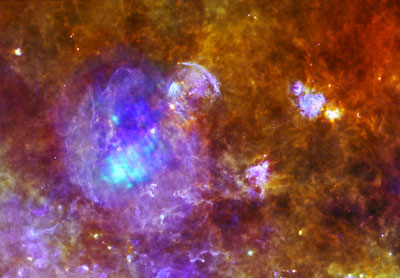| Nov 14, 2012 |
Life and death in a star-forming cloud
|
|
(Nanowerk News) The aftershock of a stellar explosion rippling through space is captured in this new view of supernova remnant W44, which combines far-infrared and X-ray data from ESA’s Herschel and XMM-Newton space observatories.
|
|
W44, located around 10 000 light-years away within a forest of dense star-forming clouds in the constellation of Aquila, the Eagle, is one of the best examples of a supernova remnant interacting with its parent molecular cloud.
|
|
The product of a massive star that has already reached the end of its life and expelled its outer layers in a dramatic explosion, all that remains of the stellar behemoth is the spinning core of a neutron star, or pulsar.
|
|
Identified as PSR B1853+01, the pulsar is the bright point to the top left in W44, coloured light blue in this image:
|
 |
| Supernova remnant W44 captured by ESA’s Herschel and XMM-Newton. (Credits: Herschel: Q. Nguyen Luong & F. Motte, HOBYS Key Program consortium, Herschel SPIRE/PACS/ESA consortia. XMM-Newton: ESA/XMM-Newton)
|
|
It is thought to be around 20 000 years old and as it rapidly rotates it sweeps out a wind of highly energetic particles and beams of light ranging from radio to X-ray energies.
|
|
The centre of the supernova remnant is also bright in X-rays, coming from the hot gas that fills the shell, at temperatures of several million degrees. Dense knots of high-energy emission reflect regions where heavier elements are more commonly found.
|
|
At the cooler edge of the cavity, gas is swept up as the supernova remnant propagates through space.
|
|
At the top right of the expanding shell, there is a smaller cavity, with the shock from the supernova remnant impacting the bight arc-shaped feature. This region is filled with hot gas that has been ionised by the intense ultraviolet radiation from embedded young massive stars.
|
|
Herschel’s far-infrared eyes can also seek out regions of gently heated gas and dust further from W44, where new stars are congregating.
|
|
Examples include the arrowhead-shaped star-formation region to the right of W44, which appears to point to another trio of intricate clouds further to the right and above.
|
|
More broadly, a number of compact objects scattered across the scene map the cold seeds of future stars that will eventually emerge from their dusty cocoons.
|
|
Finally, diffuse purple emission towards the bottom left of the image provides a glimpse of the Galactic plane.
|

